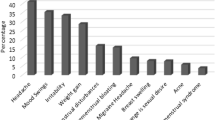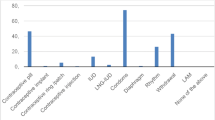Abstract
Abstract
Improving and widening Norplant use requires an understanding of users' complaints. A study was conducted of factors influencing user attitudes, with the goal of improving service delivery.
Methods
The study used a questionnaire consisting of 26 queries. An interview pertaining to the attitude of 610 users about Norplant implanted 5 years ago or more, was carried out in villages surrounding Semarang City, Central Java, Indonesia.
Result
Of the 610 Norplant users, 84.59% expressed positive attitudes; 13.93% were neutral and 1.48% expressed negative attitudes. Factors significantly affecting user acceptance were: low socio-economic status; low education; activities in social groups; young age; more experience and knowledge about Norplant; few or no complaints.
Conclusions
Acceptance of Norplant by villagers, depends on the socio-demographic status and the complaints of users. This information can be used as the basis for improving the service delivery system.
Resumé
Resumé
Pour améliorer et répandre l'utilisation de Norplant, il est nécessaire de savoir ce que les utilisatrices peuvent lui reprocher en rapport avec leurs activités journalières, leurs relations sexuelles et leurs pratiques religieuses. Une enquête a été menée pour explorer l'attitude des utilisatrices et les facteurs qui
Protocole
On a choisi la méthode fiable et valable d'un questionnaire simple mis au point à partir d'un questionnaire sans orientation précise, qui comportait 26 questions. Une enquête sur l'attitude de 610 femmes portant les implants Norplant depuis 5 ans ou plus a été conduite dans les villages autour de la ville de Semarang (île de Java, Indonésie). L'analyse des résultats de cette enquête a mis en évidence les facteurs influant sur l'attitude des utilisatrices.
Résultats
Parmi les 610 utilisatrices de Norplant, 84,59% ont exprimé leur acceptation de façon positive; 13,93% sont restées neutres et 1,48% ont eu une réaction négative. Les facteurs influant significativement sur l'acceptation positive étaient les suivants: condition socio-économiquement pauvre, bas niveau d'éducation, activités dans une organisation de caractère social, jeune âge des utilisatrices, meilleures connaissances au sujet des implants, aucun malaise ou peu.
Conclusions
Norplant est accepté par les villageoises, en fonction de leurs conditions socio-démographiques et des malaises ressentis par les utilisatrices. Cette information peut être utilisée comme base pour améliorer le service de mise à disposition.
Resumen
Resumen
El mejoramiento y la difusión del uso de Norplant requiere conocer los aspectos desfavorables que encuentran las usuarias en lo relativo a actividad diaria, relaciones sexuales y prácticas religiosas. Se realizó un estudio a fin de examinar la actitud de las usuarias y los factores de influencia, a los efectos de mejorar el suministro de este método.
Métodos
Se eligió el método fiable y válido de un cuestionario específico basado en uno de tipo más general que constaba de 26 preguntas. Una investigación relativa a la actitud de 610 usuarias de Norplant desde hacía 5 años o más se realizó en las aldeas alrededor de la ciudad de Semarang, en Java, Indonesia. El análisis de los datos reveló los factores que influían sobre la actitud de las usuarias.
Resultados
De las 610 usuarias de Norplant, el 84,59% expresó aceptación positiva; el 13,93% se mostró neutral y el 1,48% manifestó una actitud negativa. Los factores que influían significativamente sobre la aceptación positiva eran la baja categoría socioeconómica, bajo nivel de educación, actividades en una organización de carácter social, edad joven, mejores conocimientos acerca de Norplant y poco o ningún malestar.
Conclusiones
Norplant es aceptado por las habitantes de aldeas según la categoría sociodemográfica y las quejas formuladas por las usuarias. Esta información se puede utilizar como base para mejorar la prestación del servicio.
Similar content being viewed by others
References
Affandi B. Clinical, pharmacological and epidemiological studies on a levonorgestrel implant contraceptive. Dissertation, Indonesia University, December, 1987.
Kasidi HP. National Family Planning Coordinating Board, Jakarta, Indonesia. Telegram, April 1992.
Surbakti YR. Subdermal contraceptive implant. Textbook review. Dept of Obstetrics and Gynecology, Medical Faculty, North Sumatera/Dr. Pirngadi Hospital, Medan, Indonesia, 1985.
Djaja Soetisna EH. Experience on the use of long term contraceptive Norplant at Dr Hasan Sadikin Hospital and at Astana Anyar Hospital, 1981 to 1985 Bandung, Thesis., Dept of Obstetrics and Gynecology, Medical Faculty, University of Padjadjaran, Dr. Hasan Sadikin Hospital, Bandung, Indonesia, 1986.
Lubis F, Prihartono Y, Sidi IPS, Affandi B, Noerpramana NP, Sudarta AS, Triwijati N. Acceptor's attitude towards implant Norplant contraceptive in Indonesia. Medika. 1991;7:515–9.
Indonesian Association for Secure Contraception (PKMI). Program on contraceptive service betterment through training development. Presented Workshop for PKMI and Norplant training centers improving LTM service quality through training. Puncak, Indonesia. September 1991.
National Family Planning Coordinating Board of Central Java, Indonesia. The implementation of the National Program of family planning in Central Java during 1991–1992. April, 1991.
Noerpramana NP. An experience on the use, removal and reinsertion of Norplant in Central Java, Indonesia. Diponegoro Medical J. 1990;25(4):229–38.
Prihartono J, Lubis F, Affandi B, Noerpramana NP. Factors associated with due and overdue 5 year removal. Norplant Removal Study, Founded by Population Council, Yayasan Kusuma Buana, Jakarta, Indonesia, 1990.
Affandi B, Praptohardjo U. The implant levonorgestrel Norplant contraceptive in the development of obstetrics and gynecology in 1987. Varia offset printing, Jakarta, Indonesia, 1987; 57–62.
Noerpramana NP, Praptohardjo U. The experience of women having completed one year of Norplant use. The sixth Indonesian Congress of Obstetrics and Gynecology. Ujung Pandang, Indonesia, June, 1985.
Noerpramana NP. Bleeding on the use of Norplant. Presented on seminar and workshop on bleeding on the use of contraceptive. National Family Planning Coordinating Board, Indonesia, September, 1989.
Sidi IPS, Lubis F, Prihartono J, Pietoyo H, Murtikarini S, Sriyuningsih? The acceptance of Norplant among villagers. Yayasan Kusuma Buana, Jakarta, Indonesia, 1986.
Praptohardjo U, Noerpramana NP. Reports on the use of Norplant within a years time after insertion among women villagers. Presented on annual meeting of the Indonesian Association for Obstetrics and Gynecology in Medan, Indonesia, July 1984.
International Family Planning Perspective. Hormonal implants have high continuation rates and low pregnancy rates. Rates vary by country, New York. 1988;14:112–3.
Lubis F, Prihartono J, Agoestina T, Affandi B, Sutedi H. One year experience with Norplant implant in Indonesia. Stud Fam Plann. 1983;14:181–3.
Noerpramana NP. A second step study in Norplant in Central Java. The second biomedical workshop on Norplant for family planning. Jakarta, Indonesia, October 1983.
Kasijan Z. Educational psychology. PT Bina Ilmu, Surabaya. Translation from Craw, Lester D, A Craw, 1984.
Shalaludin M. Introduction to general psychology. PT Bina Ilmu, Surabaya, Indonesia, 1991.
Hadi S. Statistics. Publisher Foundation, Faculty of Psychology, University of Gajah Mada, Yogyakarta, Indonesia, 1987.
Walgito B. Issues on socio-psychology. The NKK Project of the Directorate of Higher Education, Department of Education and Culture, Jakarta, Indonesia, 1983.
Suparman IA. Social statistics. CV Rajawali, Jakarta, Indonesia, 1990;267–86.
Saing B, Sembiring L, Napitupulu L, Raid N, Siregar H. Scoring system of the socieconomic level. In Anthropometry in the newborn. Pediatr Indonesia. 1977;17:299–304.
Noerpramana NP. The Norplant removal training and service at Dr. Kariadi Hospital, Semarang, Indonesia. Adv Contracept. 1991;7:389–401.
Report of client continuation of Norplant. National Family Planning Program, Ministry of Public Health, Bangkok, Thailand, 1982.
Jonhar J. The acceptor's acceptance and perception of Norplant in San Francisco, USA (Translation). Studies in Family Planning Program, October 1990.
Author information
Authors and Affiliations
Rights and permissions
About this article
Cite this article
Noerpramana, N.P., Rusbandi Factors influencing attitudes about Norplant contraceptive subdermal implant. Adv Contracept 9, 215–226 (1993). https://doi.org/10.1007/BF01982944
Received:
Accepted:
Issue Date:
DOI: https://doi.org/10.1007/BF01982944




